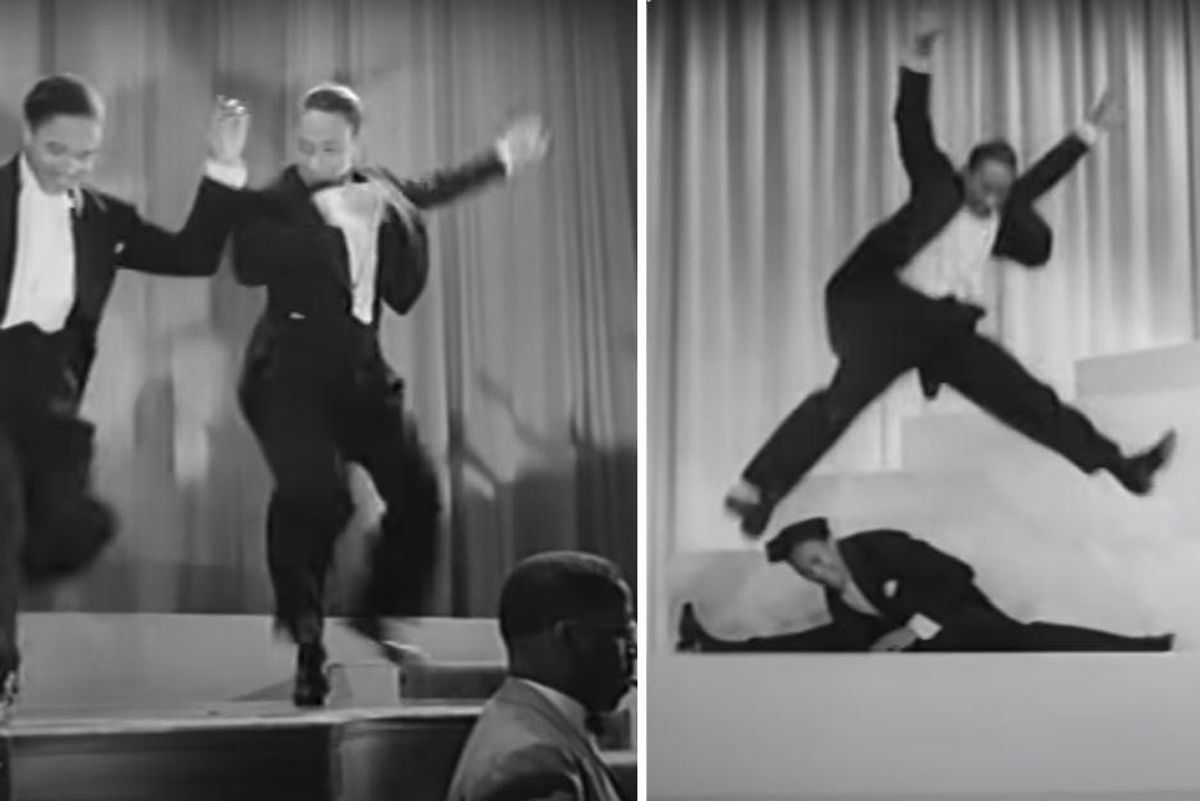This Nicholas Brothers' legendary tap routine was unrehearsed and filmed in a single take

There have been many iconic dance routines throughout film history, but how many have the honor being called "the greatest" by Fred Astaire himself?
Fayard and Harold Nicholas, known collectively as the Nicholas Brothers, were arguably the best at what they did during their heyday. Their coordinated tap routines are legendary, not only because they were great dancers, but because of their incredible ability to jump into the air and land in the splits. Repeatedly. From impressive heights.
Their most famous routine comes from the movie "Stormy Weather." As Cab Calloway sings "Jumpin' Jive," the Nicholas Brothers make the entire set their dance floor, hopping and tapping from podium to podium amongst the musicians, dancing up and down stairs and across the top of a piano.
But what makes this scene extra impressive is that they performed it without rehearsing it first and it was filmed in one take—no fancy editing room tricks to bring it all together. This fact was confirmed in a conversation with the brothers in a Chicago Tribune article in 1997, when they were both in their 70s:
"Would you believe that was one of the easiest things we ever did?" Harold told the paper.
"Did you know that we never even rehearsed that number?" added Fayard.
"When it came time to do that part, (choreographer) Nick Castle said: 'Just do it. Don`t rehearse it, just do it.' And so we did it—in one little take. And then he said: 'That's it—we can't do it any better than that.'"
Harold breathed a sigh of relief: "I sure was happy he said that—I didn't want to be doing that all night, over and over and over."
When you see the brothers' musical athleticism in action, you'll understand why:
Jumpin Jive - Cab Calloway and the Nicholas Brothersyoutu.be
As Black performers, the Nicholas Brothers faced an uphill climb in Hollywood. But no one could deny their exceptional talent.
''Oh sure, you`d see blacks playing Stepin Fetchit and maids, but you didn`t see many blacks really doing what we did,'' Harold told the Tribune. ''Somehow, it turned out that we were becoming stars—and, man, did we love it.''
However, they were usually cast as guest artists, not the main stars. According to the L.A. Times, this was a strategy that allowed their scenes to be cut from film showings in the racist American South.
Throughout their career, they worked with other famous dancers. The brothers told the Tribune a funny story about working with Gene Kelly, whom Harold called "a perfectionist." Harold said he didn't think Kelly appreciated his laid-back approach to rehearsing and the fact that he wasn't a workaholic.
''He and Fayard would be rehearsing this number over and over, as if the camera was running, which means that you're doing it full force," Harold told the Tribune. ''But I never liked to go all out during the rehearsal—I liked to reign it in, reign it in.''
What Gene Kelly didn't understand was that once the lights went on, Harold would go all out.
Fayard said that Gene once said he wanted to see Fayard do a routine by himself because he didn't think Harold had gotten it down.
''And then Harold did it and didn't miss a step," Fayard said, "so Gene looked at me and said: 'Well, I'll be an SOB.'''
The Nicholas Brothers continued to perform throughout their lives, long after their particular style of dancing had waned in popularity. Harold Nicholas passed away in 2000 at age 79, while the older of the brothers, Fayard, passed in 2006 at age 91.
Thank goodness for film that allows their legacy to live on and allows us to enjoy their contributions for generations to come.
- Remember the man who was bullied for dancing a few months ago ... ›
- Ghana's dancing pallbearers have a message for anyone who isn't ... ›
- A former ballerina with Alzheimer's hears 'Swan Lake' and bursts ... ›
- What are the best dance scenes in movie history? - Upworthy ›



 Millennial mom struggles to organize her son's room.Image via Canva/fotostorm
Millennial mom struggles to organize her son's room.Image via Canva/fotostorm Boomer grandparents have a video call with grandkids.Image via Canva/Tima Miroshnichenko
Boomer grandparents have a video call with grandkids.Image via Canva/Tima Miroshnichenko

 Worried mother and children during the Great Depression era. Photo by Dorthea Lange via Library of Congress
Worried mother and children during the Great Depression era. Photo by Dorthea Lange via Library of Congress  A mother reflects with her children during the Great Depression. Photo by Dorthea Lange via Library of Congress
A mother reflects with her children during the Great Depression. Photo by Dorthea Lange via Library of Congress  Families on the move suffered enormous hardships during The Great Depression.Photo by Dorthea Lange via Library of Congress
Families on the move suffered enormous hardships during The Great Depression.Photo by Dorthea Lange via Library of Congress
 A couple cooking in the kitchen with a cat sitting on the table beside chopped ingredients.
A couple cooking in the kitchen with a cat sitting on the table beside chopped ingredients.